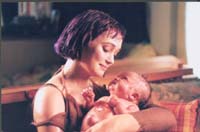 How many of you have a birthmark?
How many of you have a birthmark?
They are fairly common and even if you don’t have one now you may have had one as a baby. The are quite a few types of birthmarks and most are harmless but keeping them protected from the sun is a good idea.
A birthmark is a skin marking that is discolouration or overgrowth of tissue on the skin. They mostly present themselves at birth and range in color from brown or black to bluish or blue-gray and also red. Birthmarks include cafe-au-lait spots, moles, mongolian spots, port wine stains and hemangiomas.
Cafe-au-lait spots are the colour of coffee with milk, a light tan colour. They may be a normal type of birthmark and doesn’t usually cause much worry and are often hardly noticed.
Moles are small clusters of pigmented skin cells. Nearly everyone has moles, which usually appear after birth.
Congenital nevi (moles you are born with) have an increased risk of becoming skin cancer (malignant melanoma). This is especially true if the mole covers a large area of the body (larger than a fist). All congenital moles should be examined by a health care provider and any change in the birthmark should be reported. Watch for changes in the size or color, or the appearance of sudden ulceration, bleeding, or itching in the birthmark.
A mongolian spot (also called a mongolian blue spot) is usually bluish or bruised-looking. It usually appears over the lower back or buttocks, sometimes in other areas including the trunk or arms. These are more commonly seen in darker-skinned populations and may persist for months or years but do not become cancer or develop other symptoms. They usually disappear without treatment bby school age.
Port wine stains are flat birthmarks that are pink-red in colour but can darken to red-purple over time. They are often found on the face but can occur anywhere on the body and are caused by an overgrowth of blood vessels. Unfortunately they do not fade or go away and some people choose to have them removed with surgery or with laser therapy.
Hemangiomas are birthmarks that form when many blood vessels bunch together. There are three types of hemangiomas.
The first are called Stork bites and these are like pink flat patches that are frequently found in the hairline and on the back of the neck. They are most common in babies and are more noticeable when a baby is hot or crying. Stork bites usually fade without any treatment in the first 2 years of life.
The second are Strawberry Hemangiomas. These are thicker raised areas that are soft and purple/red in colour. They can be smooth or slightly bumpy and can be irregular in shape. They can be present at birth or they can develop a few months after birth. They are most common on the back, chest, face and scalp but can occur anywhere. They are unpredictable and can not grow at all, grow slowly or grow rapidly. After a period of no growth they often begin to shrink and can disappear all together.
Deep hemangiomas are thicker and deeper and are often raised areas of purple-blue. They may feel like spongy tissue. They will often fade as a child gets older. However because they are deeper in the skin they may not totally shrink or go away and may require cosmetic surgery at a later date.
Should I visit a doctor?
A birthmark that is quite large or located in an area where it interferes with functions such as eating will require medical attention. A doctor will note any birthmarks and measure them and see if they change over time. This can give a good indication on whether any treatment is necessary. If there is a problem then your doctor may refer you to a dermatologist or plastic surgeon to have it treated or removed. But in most cases birthmarks are harmless.
Things to look out for
There are certain things you should keep an eye out for in birthmarks and moles
Call your doctor if:
• A birthmark changes in size, color or shape
• A birthmark bleeds or itches
• A birthmark becomes sore or tender
• Any new molelike growths appear, especially if they are irregularly shaped, discolored or large
Remember to try and keep any birthmarks or moles out of the sun.

